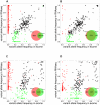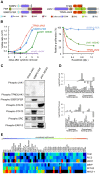Comprehensive analysis of transcriptome variation uncovers known and novel driver events in T-cell acute lymphoblastic leukemia
- PMID: 24367274
- PMCID: PMC3868543
- DOI: 10.1371/journal.pgen.1003997
Comprehensive analysis of transcriptome variation uncovers known and novel driver events in T-cell acute lymphoblastic leukemia
Abstract
RNA-seq is a promising technology to re-sequence protein coding genes for the identification of single nucleotide variants (SNV), while simultaneously obtaining information on structural variations and gene expression perturbations. We asked whether RNA-seq is suitable for the detection of driver mutations in T-cell acute lymphoblastic leukemia (T-ALL). These leukemias are caused by a combination of gene fusions, over-expression of transcription factors and cooperative point mutations in oncogenes and tumor suppressor genes. We analyzed 31 T-ALL patient samples and 18 T-ALL cell lines by high-coverage paired-end RNA-seq. First, we optimized the detection of SNVs in RNA-seq data by comparing the results with exome re-sequencing data. We identified known driver genes with recurrent protein altering variations, as well as several new candidates including H3F3A, PTK2B, and STAT5B. Next, we determined accurate gene expression levels from the RNA-seq data through normalizations and batch effect removal, and used these to classify patients into T-ALL subtypes. Finally, we detected gene fusions, of which several can explain the over-expression of key driver genes such as TLX1, PLAG1, LMO1, or NKX2-1; and others result in novel fusion transcripts encoding activated kinases (SSBP2-FER and TPM3-JAK2) or involving MLLT10. In conclusion, we present novel analysis pipelines for variant calling, variant filtering, and expression normalization on RNA-seq data, and successfully applied these for the detection of translocations, point mutations, INDELs, exon-skipping events, and expression perturbations in T-ALL.
Conflict of interest statement
The authors have declared that no competing interests exist.
Figures





Similar articles
-
Indel sensitive and comprehensive variant/mutation detection from RNA sequencing data for precision medicine.BMC Med Genomics. 2018 Sep 14;11(Suppl 3):67. doi: 10.1186/s12920-018-0391-5. BMC Med Genomics. 2018. PMID: 30255803 Free PMC article.
-
Indel detection from RNA-seq data: tool evaluation and strategies for accurate detection of actionable mutations.Brief Bioinform. 2017 Nov 1;18(6):973-983. doi: 10.1093/bib/bbw069. Brief Bioinform. 2017. PMID: 27473065 Free PMC article.
-
Inconsistency and features of single nucleotide variants detected in whole exome sequencing versus transcriptome sequencing: A case study in lung cancer.Methods. 2015 Jul 15;83:118-27. doi: 10.1016/j.ymeth.2015.04.016. Epub 2015 Apr 23. Methods. 2015. PMID: 25913717 Free PMC article.
-
[Genetic basis of pediatric T-cell acute lymphoblastic leukemia and its clinical impact].Rinsho Ketsueki. 2018;59(7):953-959. doi: 10.11406/rinketsu.59.953. Rinsho Ketsueki. 2018. PMID: 30078808 Review. Japanese.
-
Exome versus transcriptome sequencing in identifying coding region variants.Expert Rev Mol Diagn. 2012 Apr;12(3):241-51. doi: 10.1586/erm.12.10. Expert Rev Mol Diagn. 2012. PMID: 22468815 Review.
Cited by
-
Deletions of the long arm of chromosome 5 define subgroups of T-cell acute lymphoblastic leukemia.Haematologica. 2016 Aug;101(8):951-8. doi: 10.3324/haematol.2016.143875. Epub 2016 May 5. Haematologica. 2016. PMID: 27151989 Free PMC article.
-
RNA sequencing unravels the genetics of refractory/relapsed T-cell acute lymphoblastic leukemia. Prognostic and therapeutic implications.Haematologica. 2016 Aug;101(8):941-50. doi: 10.3324/haematol.2015.139410. Epub 2016 May 5. Haematologica. 2016. PMID: 27151993 Free PMC article.
-
Case Report: Rare IKZF1 Gene Fusions Identified in Neonate with Congenital KMT2A-Rearranged Acute Lymphoblastic Leukemia.Genes (Basel). 2023 Jan 19;14(2):264. doi: 10.3390/genes14020264. Genes (Basel). 2023. PMID: 36833191 Free PMC article.
-
β-Catenin activity induces an RNA biosynthesis program promoting therapy resistance in T-cell acute lymphoblastic leukemia.EMBO Mol Med. 2023 Feb 8;15(2):e16554. doi: 10.15252/emmm.202216554. Epub 2023 Jan 4. EMBO Mol Med. 2023. PMID: 36597789 Free PMC article.
-
Integrated analysis of gene network in childhood leukemia from microarray and pathway databases.Biomed Res Int. 2014;2014:278748. doi: 10.1155/2014/278748. Epub 2014 Apr 15. Biomed Res Int. 2014. PMID: 24822192 Free PMC article.
References
-
- Pieters R, Carroll WL (2008) Biology and treatment of acute lymphoblastic leukemia. Pediatr Clin North Am 55: 1–20–ix doi:10.1016/j.pcl.2007.11.002 - DOI - PubMed
-
- van Vlierberghe P, Ferrando A (2012) The molecular basis of T cell acute lymphoblastic leukemia. J Clin Invest 122: 3398–3406 doi:10.1172/JCI61269 - DOI - PMC - PubMed
-
- Graux C, Cools J, Michaux L, Vandenberghe P, Hagemeijer A (2006) Cytogenetics and molecular genetics of T-cell acute lymphoblastic leukemia: from thymocyte to lymphoblast. Leukemia 20: 1496–1510 doi:10.1038/sj.leu.2404302 - DOI - PubMed
-
- Le Noir S, Ben Abdelali R, Lelorch M, Bergeron J, Sungalee S, et al. (2012) Extensive molecular mapping of TCRα/δ- and TCRβ-involved chromosomal translocations reveals distinct mechanisms of oncogene activation in T-ALL. Blood 120: 3298–3309 doi:10.1182/blood-2012-04-425488 - DOI - PubMed
-
- Van Vlierberghe P, Homminga I, Zuurbier L, Gladdines-Buijs J, van Wering ER, et al. (2008) Cooperative genetic defects in TLX3 rearranged pediatric T-ALL. Leukemia 22: 762–770 doi:10.1038/sj.leu.2405082 - DOI - PubMed
Publication types
MeSH terms
LinkOut - more resources
Full Text Sources
Other Literature Sources
Molecular Biology Databases
Miscellaneous

